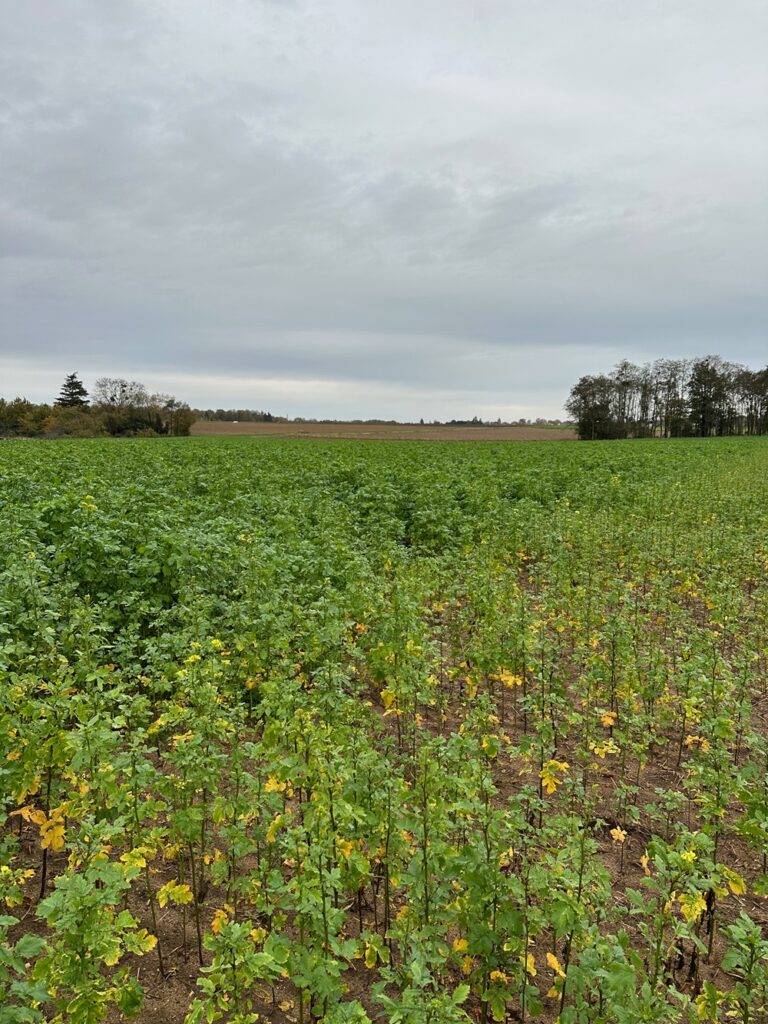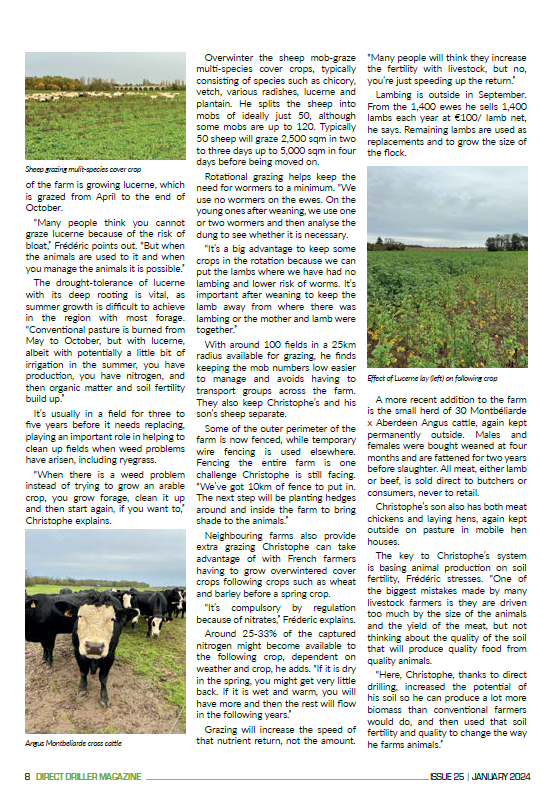On a recent BASE-UK trip to France, a visit to Christophe Piou’s farm showed how you don’t have to follow the herd to be successful
By Mike Abram
Surrounded by high value vegetable production and arable farms in the Loire Valley is what is now predominantly a livestock farm.
It wasn’t always that way. When Christophe Piou started farming in 1999 the farm was an arable farm but gradually over the past 20 years livestock have become an increasing part of the farm.
Although from a farming family, prior to 1998, Christophe worked as an accountant for eight years. But after studying agriculture for a year in 1998, he bought a 110ha farm in Saint-Claude-de-Diray, close to Blois to the south of Paris, around 15km away from his father’s 140ha farm, which they ran in partnership.
The two had very different soil types. Christophe’s farm is on sands, so the main concern is drought, although he has access to irrigation. On his father’s farm, which he now runs, the soil is sand overlying clay. Here, excess water particularly in winter is the challenge, as the clay pan underneath stops the water from draining away.

“The yield potential is very low,” Christophe says. “So we had to cover a large area in order to secure an income, meaning we were also doing another 200ha of contract work.”
Christophe’s accountancy background also meant he approached farming with a financial management perspective. A minimum or zero tillage system was partially adopted, due to the savings in machinery and labour costs, with a trip in 1986 to direct drilling demonstration with his father laying the foundations for the switch.
That was consolidated after meeting Frédéric Thomas, a pioneer in conservation agriculture, in 2001, who farmed around 25km away and was looking for a partner to help on his farm while he was away from home.
“On our first meeting we took a spade around the farm, and it was the first time I’d been around the field with a spade as a farmer,” Christophe admits.

“We discovered a plough pan on which water was sitting at a depth of 25-30cm, and also a power harrow pan. Both were affecting rooting of the winter crops and a good explanation of the low yield potential.”
A comparison with Frédéric’s own farm which at that stage was around five years ahead in using conservation agriculture practices further highlighted to Christophe the obvious difference.
He also used every BASE France trip possible to increase his knowledge base both from the farmers and advisers they visited but also the other people on the trip.
“During the next 10 years we increased our soil organic matter content from 0.8 to 2.5%. We went from zero cover crops to 100% cover crops, from 200kg to 2t/ha of earthworms.
“It was working well economically until around 2007 when the wheat price jumped sky high, expenses followed and then the wheat price crashed, making the economics difficult.”
But the final straw was in 2016, when 200mm of rain in June caused floods in much of the wheat growing land south east of Paris, including the Loire Valley and most of Christophe’s 260ha of crops. “Winter wheat yields were 2t instead of 6t/ha, durum wheat 1t instead of 5t/ha. I lost €200,000 of turnover, and the accountant was not insured.
“Today, I learn, I told myself. If we are able to lose €100,000 in farming, this means if we are smarter, we can make €100,000.”
But it has required a pretty big shift in system. Again, the plan had its roots in an earlier BASE France trip – this time to North and South Dakota in the US, although ironically it was there, he and Frédéric first heard of a French biochemist and farmer, André Voisin, and his theory of rational grazing. Voisin developed in the 1950s what have effectively become the principles for most modern rotational grazing systems.

“We had to go all the way to the US to hear about a famous French guy we didn’t know, but some of the farmers knew a lot about him and his teaching about how to get grass and cow working well together.”
It became the moment when Christophe knew he had to bring animals back on the farm as he had lots of food available thanks to the cover crops.
Following that trip he started to look for someone who could manage livestock on his farm, but it took three years until he found someone suitable – Jose, a security guard, who was keen to change careers.
Despite the drawback that Jose knew nothing about sheep, Christophe bought 50 sheep and Frédéric provided 5ha on which to feed the sheep as a one-year trial. It went well and by the time of the 2016 floods Jose had expanded to 150 ewes, plus some of his own land.
The experience gave Christophe the idea that he could develop a system with sheep or cattle outside all year round, which would be more profitable and more resilient. “I went to New Zealand and saw a farm with 400ha with 2000 sheep and some cows, and the farmer was able to make €200,000 net after income tax without any subsidy, and it seemed quite easy. In our system, we have a €100,000 support payment on top.”
From the initial 50 ewes in 2015, he now runs 1400 in total – 400 of which belong to his son, who came back to farm in 2020. “We only grow 100ha of crops out of the 400ha total farmed.”
The sheep enterprise helps organise the rotation. Around 100ha of the farm is growing lucerne, which is grazed from April to the end of October.
“Many people think you cannot graze lucerne because of the risk of bloat,” Frédéric points out. “But when the animals are used to it and when you manage the animals it is possible.”
The drought-tolerance of lucerne with its deep rooting is vital, as summer growth is difficult to achieve in the region with most forage. “Conventional pasture is burned from May to October, but with lucerne, albeit with potentially a little bit of irrigation in the summer, you have production, you have nitrogen, and then organic matter and soil fertility build up.”

It’s usually in a field for three to five years before it needs replacing, playing an important role in helping to clean up fields when weed problems have arisen, including ryegrass.
“When there is a weed problem instead of trying to grow an arable crop, you grow forage, clean it up and then start again, if you want to,” Christophe explains.
Overwinter the sheep mob-graze multi-species cover crops, typically consisting of species such as chicory, vetch, various radishes, lucerne and plantain. He splits the sheep into mobs of ideally just 50, although some mobs are up to 120. Typically 50 sheep will graze 2,500 sqm in two to three days up to 5,000 sqm in four days before being moved on.
Rotational grazing helps keep the need for wormers to a minimum. “We use no wormers on the ewes. On the young ones after weaning, we use one or two wormers and then analyse the dung to see whether it is necessary.
“It’s a big advantage to keep some crops in the rotation because we can put the lambs where we have had no lambing and lower risk of worms. It’s important after weaning to keep the lamb away from where there was lambing or the mother and lamb were together.”
With around 100 fields in a 25km radius available for grazing, he finds keeping the mob numbers low easier to manage and avoids having to transport groups across the farm. They also keep Christophe’s and his son’s sheep separate.
Some of the outer perimeter of the farm is now fenced, while temporary wire fencing is used elsewhere. Fencing the entire farm is one challenge Christophe is still facing. “We’ve got 10km of fence to put in. The next step will be planting hedges around and inside the farm to bring shade to the animals.”
Neighbouring farms also provide extra grazing Christophe can take advantage of with French farmers having to grow overwintered cover crops following crops such as wheat and barley before a spring crop.
“It’s compulsory by regulation because of nitrates,” Fréderic explains.
Around 25-33% of the captured nitrogen might become available to the following crop, dependent on weather and crop, he adds. “If it is dry in the spring, you might get very little back. If it is wet and warm, you will have more and then the rest will flow in the following years.”
Grazing will increase the speed of that nutrient return, not the amount. “Many people will think they increase the fertility with livestock, but no, you’re just speeding up the return.”
Lambing is outside in September. From the 1,400 ewes he sells 1,400 lambs each year at €100/ lamb net, he says. Remaining lambs are used as replacements and to grow the size of the flock.

A more recent addition to the farm is the small herd of 30 Montbéliarde x Aberdeen Angus cattle, again kept permanently outside. Males and females were bought weaned at four months and are fattened for two years before slaughter. All meat, either lamb or beef, is sold direct to butchers or consumers, never to retail.
Christophe’s son also has both meat chickens and laying hens, again kept outside on pasture in mobile hen houses.
The key to Christophe’s system is basing animal production on soil fertility, Frédéric stresses. “One of the biggest mistakes made by many livestock farmers is they are driven too much by the size of the animals and the yield of the meat, but not thinking about the quality of the soil that will produce quality food from quality animals.
“Here, Christophe, thanks to direct drilling, increased the potential of his soil so he can produce a lot more biomass than conventional farmers would do, and then used that soil fertility and quality to change the way he farms animals.”




